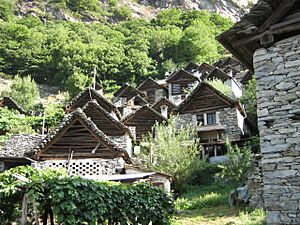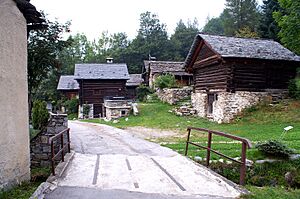Lavizzara facts for kids
Quick facts for kids
Lavizzara
|
||
|---|---|---|

Fusio village
|
||
|
||
| Country | Switzerland | |
| Canton | Ticino | |
| District | Vallemaggia | |
| Area | ||
| • Total | 187.53 km2 (72.41 sq mi) | |
| Elevation | 763 m (2,503 ft) | |
| Population
(Dec 2020 )
|
||
| • Total | 500 | |
| • Density | 2.67/km2 (6.9/sq mi) | |
| Postal code |
6692-6696
|
|
| Localities | Broglio, Brontallo, Fusio, Menzonio, Mogno, Monti di Rima, Peccia, Piano di Peccia, Prato, San Carlo, Sant'Antonio, Sornico | |
| Surrounded by | Airolo, Bedretto, Brione (Verzasca), Cevio, Chironico, Dalpe, Maggia, Prato Leventina, Quinto, Sonogno | |
Lavizzara is a town in the Vallemaggia area of Ticino, a canton in Switzerland.
This town was formed in 2004. It was created when several smaller villages joined together. These villages were Broglio, Brontallo, Fusio, Menzonio, Peccia, and Prato-Sornico.
Contents
History of Lavizzara's Villages
The villages that make up Lavizzara have a long history. Each one has its own story, going back hundreds of years.
Broglio: A Village That Grew Over Time
The village of Broglio was first mentioned in records in 1361. It grew in different stages over the centuries. In 1374, the Lavizzara valley community split up, and Broglio became its own area. It grew more in the late 1500s through agreements with nearby communities.
The Church of S. Maria Lauretana was built in 1487. It was rebuilt and fixed many times later. It became its own church parish in 1616. A famous old building, Casa Pometta, dates back to the 1600s.
Broglio had the most people in the 1600s. But then, people started moving away, especially in the late 1800s. They went to bigger cities or other countries. For a long time, farming and raising animals were the main jobs. Now, many houses in Broglio are used for vacations.
Brontallo: A Community with Ancient Roots
Brontallo was once part of a larger community with Menzonio until the early 1400s. It also shared a special community group called a Vicinanza with Bignasco and Cavergno.
The Church of S. Maria e S. Giorgio was first mentioned in the 1400s. It was rebuilt in the 1500s and fixed up many times after that. Brontallo became its own church parish in 1655.
Like Broglio, Brontallo had its largest population in the 1600s. Its population started to drop in the 1700s and even faster in the 1900s. A road connecting the village to the main valley was finished in 1955. Today, many homes in Brontallo are used for holidays.
Fusio: A Mountain Village's Journey
Fusio was first mentioned in 1258. Its population was highest in the 1500s and 1600s, with 400-500 people. After 1950, many people moved to cities, and the population dropped a lot. Most people living there now are older.
The local church, dedicated to the Beata Vergine Assunta, was built in 1455. It was rebuilt several times, especially in the 1600s.
The main jobs in Fusio were raising animals, using pastures, and forestry. The village had large areas for grazing animals. Two mines in the village produced steatite (soapstone) until the late 1800s. A dam was built in the Sambuco valley (1950–56), which reduced the amount of farmland. Since the 1980s, more houses and an inn have been built for visitors.
The small village of Mogno was also part of Fusio. In the 1600s, it had about 50 homes that paid taxes. By 1801, only 40 people lived there. Today, Mogno is mostly a holiday village and not lived in all year.
The church of San Giovanni Battista Decollato in Mogno was built in 1626. It was destroyed by an avalanche in 1986. A new, unique church was built in 1997 by a famous architect named Mario Botta. This new building is now a popular place to visit.
Menzonio: A Village with Changing Borders
Menzonio and Brontallo were one town until the early 1400s. Menzonio was one of seven villages in the Lavizzara valley when the Swiss Confederation ruled Ticino.
The village church was part of the Cevio church area until 1513. Then, it joined Brontallo to form a new church area. In 1655, Menzonio became its own church parish. The Church of SS Giacomo e Filippo was first mentioned in the 1400s. The current building was built in 1585 and rebuilt in 1644 and 1905.
Menzonio's population was highest in the 1600s. People then started moving away, first to Italy, then to California, and later to cities in Switzerland.
For centuries, the main jobs were grazing animals and farming. In the 1800s, there was a soapstone quarry and four mills. A road connecting Menzonio to the valley floor was built in 1949. Today, many people who live in Menzonio travel to other places for work.
Peccia: A Center for Stone and Power
Peccia was part of the larger Lavizzara valley community until 1374. When that community split, Peccia became the largest village in the area. It included Mogno and the Valle di Peccia, which was independent until 1669. Four communities (Fusio, Peccia, Prato, and Sornico) shared land until 1929.
Peccia was part of the Sornico church area until 1613. Then, the church of S. Antonio Abate in Peccia became its own church parish. The church was built in the 1500s. After floods in 1834 and 1868 damaged the village, the church was completely rebuilt.
In the early 1900s, many jobs in Peccia involved digging up, shaping, and selling soapstone. Since 1946, white marble has also been mined here. This is the only marble quarry in Switzerland! In 1984, a sculpting school was started because of the marble. This marble was even used to rebuild the church in Mogno after an avalanche destroyed it in 1986.
Today, making things (manufacturing) provides more than a third of the jobs in Peccia. From 1950-56, one of Switzerland's largest hydroelectric power plants was built in the Valle di Peccia. It uses water from the Maggia river. In recent years, the village has also worked to improve things for tourists.
Prato-Sornico: A Historically Important Village
Prato and Sornico were part of the Lavizzara valley community until 1374, when they became independent villages. Like Peccia, they shared land with Fusio and Peccia until 1929. In the 1400s, this area was important for the valley's government. It was even the home of the Swiss Confederation governor from 1513 to 1798. After 1803, it was the capital of the Lavizzara sub-district.
Old, grand houses in the village show its past importance. One house, built in the 1400s, was once a prison and the home of a bailiff (a local official). Another house, Casa Berna, from the 1700s, holds a large library.
The church of San Martino in Sornico was first mentioned in the 1300s, but it might be even older, from the 1000s. It was the main church for the Val Lavizzara in the 1500s. The church of SS Fabiano e Sebastiano in Prato was built in 1487 and rebuilt in 1730.
In the 1800s and 1900s, many people moved away from Prato-Sornico to other countries and cities. Even so, about one-third of the workers in this mountain village still work in farming today. In recent decades, many vacation homes and tourist facilities have been built.
Geography of Lavizzara
Lavizzara covers an area of about 187.5 square kilometers (72.4 square miles). Here's how the land is used:
- Forests: About 30.2% of the land is covered by forests.
- Unproductive Land: A large part, about 51.6%, is land that can't be used for farming or building. This includes rocky areas and places with little plant life.
- Agricultural Land: Only about 1.0% of the land is used for farming.
- Settled Areas: About 0.7% of the land has buildings or roads.
- Rivers and Lakes: About 2.3% of the area is covered by water, like rivers and lakes.
Population of Lavizzara
Lavizzara has a population of 500 people. All of them are Swiss citizens. Over the past 10 years (1997–2007), the number of people living here has stayed about the same.
In 2008, about 50.4% of the population were boys and men, and 49.6% were girls and women.
The age groups in Lavizzara in 2009 were:
- Children (0-9 years old): 9.1%
- Teenagers (10-19 years old): 11.3%
- Young Adults (20-29 years old): 9.8%
- Adults (30-59 years old): 37.3%
- Seniors (60 years and older): 32.5%
Historical Population Trends
The chart below shows how the population of the different villages in Lavizzara has changed over time. You can see how the number of people in each village went up and down through the years.

Important Heritage Sites
Some places in Lavizzara are very important for their history and culture. The A Mott D’Orei Settlement is a special heritage site of national significance in Switzerland. Also, the villages of Broglio, Brontallo, Fusio, Prato, Sornico, and Cortignelli are all part of the Inventory of Swiss Heritage Sites. This means they are protected because of their historical value.
Economy: How People Make a Living
In 2008, there were 161 full-time jobs in Lavizzara. Here's a look at the main types of jobs:
- Primary Sector (Farming): 33 jobs were in agriculture, like farming and raising animals.
- Secondary Sector (Making Things): 62 jobs were in this sector.
- 7 jobs (11.3%) were in manufacturing, which means making products.
- 10 jobs (16.1%) were in mining, like digging for stone.
- 35 jobs (56.5%) were in construction, building things.
- Tertiary Sector (Services): 66 jobs were in services.
- 28 jobs (42.4%) were in moving and storing goods.
- 20 jobs (30.3%) were in hotels or restaurants.
- Other jobs included sales, finance, science, and education.
In 2009, Lavizzara had 4 hotels with a total of 19 rooms and 35 beds, showing its growing tourism.
Education in Lavizzara
In 2009, there were 90 students in Lavizzara. Switzerland has a good education system.
- Kindergarten: Children can go to kindergarten for up to three years. In Lavizzara, 12 children were in kindergarten.
- Primary School: This program lasts for five years. 23 students attended primary schools in the village.
- Lower Secondary School: After primary school, students can choose different paths.
- Some go to a two-year middle school (25 students) and then learn a trade.
- Others go to a four-year program (7 students) to get ready for higher education.
- Upper Secondary School: This level prepares students for jobs or college.
- 6 students were in full-time vocational school, learning a trade.
- 16 students were in part-time vocational school.
- Professional Programs: These programs last three years and prepare students for jobs in fields like engineering or tourism. 1 student was in a professional program.
See also
 In Spanish: Lavizzara para niños
In Spanish: Lavizzara para niños









